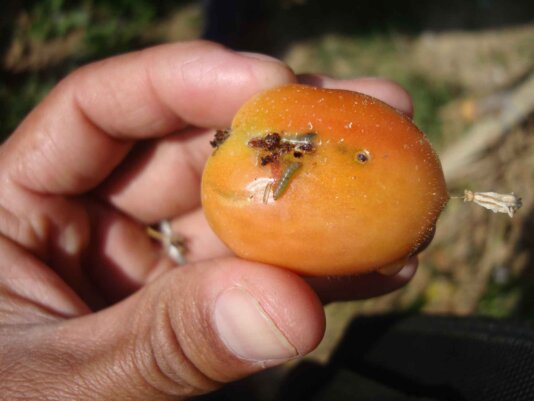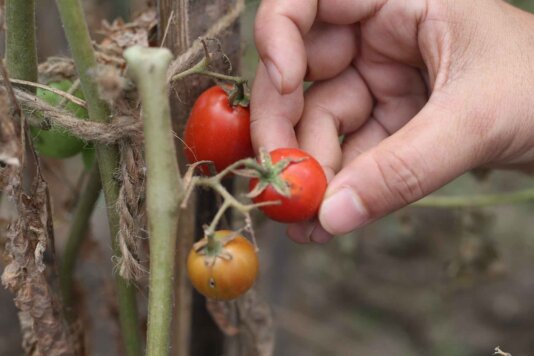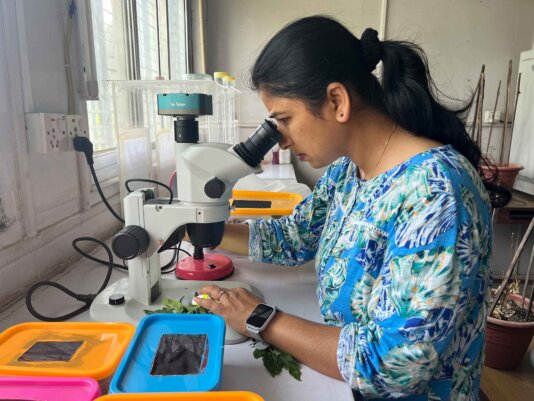- About
- Topics
- Picks
- Audio
- Story
- In-Depth
- Opinion
- News
- Donate
- Signup for our newsletterOur Editors' Best Picks.Send
Read, Debate: Engage.
| May 23, 2024 | |
|---|---|
| topic: | Sustainable Agriculture |
| tags: | #Nepal, #pesticides, #Sustainable Agriculture |
| located: | Nepal |
| by: | Sonam Lama Hyolmo |
When researchers at Nepal’s Entomology Division first recorded Tuta absoluta seven years ago, the tomato leaf miner was already detected in 14 locations in five districts across the country.
The division, which ran under the Nepal Agriculture Research Council (NARC), initiated a thorough study of the alien moth species that was threatening the future of tomato farming in Nepal.
Tomato has recently become one of Nepal's major cash crops, with its demand soaring in both local markets and neighboring India. Nepali farmers grow tomatoes on 22,600 hectares and produce more than 432,000 tonnes annually, according to the Agriculture Ministry.
A month of laboratory research and experimentation at the division resulted in the development of Integrated Pest Management (IPM), a method that successfully salvaged numerous tomato farms.
Tomato farmers in Kavrepalanchowk reportedly lost half of their crops during the first infestation in 2016. This number continued to swell, and by 2018 the invasive pest had spread to 41 districts spanning more than half of the country with no solution in sight for farmers.
"It was never-too-late a process conducting an extensive study and exploring solutions to control the pest," Ajaya Shree Ratna Bajracharya, a senior research scientist at NARC, told FairPlanet.
"However, the challenge always remains - is the IPM method designed farmer-centric, cost-effective and environment-friendly?"
Back in the fields, an immediate response began as farmers experimented with a number of pesticides to cope with the infestation. Meanwhile, scientists at NARC were seeking sustainable alternatives to address the problem, which by now was spreading on a larger scale. It was at that point when the IPM method for pest control was introduced.
IPM is a pest control method derived from research and technology. It is a process developed by studying moth physiology and behaviour, prioritising biological control methods with the judicious application of safe pesticides. The method primarily focuses on disrupting the life cycle of the moth species and preventing them from developing into the larvae stage, which is considered to be the insect’s most active state.
Bajracharya highlights key measures within IPM to contain the pest by disrupting its life cycle. His observation shows that farmers who have learned and implemented the method over a longer period have yielded better outcomes.
"Maintaining sanitation, pheromone trapping of adult male moths and safe/balanced use of pesticides is key to having effective control over the infestation," he said.
Binu Bhat, a technical officer at the NARC laboratory, described the life cycle of the moth while dissecting a tomato leaf to examine a larva under a microscope. She explained that the IPM method is designed by studying a moth's physiology and behaviour, which triggers specific reactions from them.
For example, the use of pheromone traps is one effective measure, attracting and capturing or killing adult male moths drawn to sex pheromones on Tuta lures installed in the field. Pheromones act as natural sexual attractants. This process disrupts the mating activity of adult moths, thus diluting the moth population.
"Sticky and light traps are among other options, however, sticky traps are less cost-effective while light traps attract beneficial insects other than Tuta moths," Bhat added.
Likewise, timely monitoring and the proper disposal of symptomatic leaves in high-density plastic bags are crucial for permanently destroying eggs and larvae. Finally, the judicious use of safer pesticides ensures that the process is carried out without harming humans or the environment.
IPM is cost-effective for farmers, said Raghu Chandrabanshi, a 34-year-old farmer from Sunsari District. After facing a pest outbreak in his tomato crop, he adopted the method in his newly-established Sundar Krishi Farm located in Barahakshetra Municipality.
"Of eight hectares [of farmland], I had [only] harvested tomatoes in about a hectare, and it was getting out of hand to contain the pest, despite trying a number of pesticides," Chandrabanshi told FairPlanet.
With a population of 91,891 across 21,961 households, Barahakshetra Municipality annually produces 158.12 metric tonnes (MT) of tomatoes. While the locally produced tomatoes last for six months, for the remaining half of the year, tomatoes are imported from neighbouring India.
That said, tomato farming has been impacted by tuta absoluta by 30-80 percent, resulting in an annual loss to farmers of approximately Rs 23 lakh (USD 17,000). In an attempt to mitigate and minimise the damage, some 125 farmers were provided a 16-week IPM training by the municipality on awareness-raising regarding tuta absoluta and pest-free vegetable farming.
They ended up adopting the IPM technique, which reportedly reduced the damage inflicted by the pest.
Farmers like Chandrabanshi are now preventing infestations using IPM, investing small amounts in Tuta lure/traps (less than USD 1 per trap) and employing pesticides such as Chlorantraniliprole, which is pricer, and Spinosad, which is less expensive compared to other products.
A 2023 study indicated that increased efficacy can be observed when such chemicals are used in combination with plant extracts. "The situation is far better now," a farmer quoted in the study claims. "I alternately use biopesticides like Neem (Azadirachta indica) to have effective control against tuta."
According to Bajracharya from NARC, both of these chemicals are recommended under IP) to control pests because they are comparatively safer and can be applied in small quantities over large areas.
He noted that 1 ml of pesticide mixed with 3 ml of water is sufficient for application and should be sprayed at intervals of 10-15 days. However, he added that the use of pesticides is just one component of the IPM method.
Although these chemicals are recommended for pest control, studies have revealed their inefficacy due to the insect's rapid reproductive rate and quick development of resistance to pesticides.
In a journal published in 2018, Plant Protection Directorate Nepal recommended the use of pesticides to minimise their side effects, but also suggested avoiding the overuse of pesticides to reduce the ability of pests to develop immunity.
Nevertheless, farmers in agro-based regions like Terai often resort to using pesticides available at local Agrovets, private chemical/pesticide stores, due to limited knowledge about proper chemical usage, which can lead to adverse health effects.
The worst-case scenario is when illiterate farmers are provided with a variety of pesticides without a label or instruction on the chemical usage. In such cases, farmers become vulnerable to acute health impacts including neurotransmitter dysfunction, disruption of the endocrine system and cancer.
"Chemical pesticides are no great solution, but the right choice can help minimise risks at a greater scale," said Bhat.
The importance of chemical awareness through training is thus crucial to sensitise farmers on pesticide safety and judicious use and handling, experts say. Over the past three years, the Agriculture Development Division of Barahchhhetra Municipality has trained roughly 500 farmers in 11 sessions organised by the municipality.
However, "there is a need for much more sharing and interaction," Nir Bahadur Rai, Junior Technician Assistant at the municipality, told FairPlanet.
Chandrabanshi echoes Rai's opinion. In 2019, when the Fall Armyworm was first detected in Nepal, IPM began to be used to control the pest. Farmers like him attribute the rise in invasive pests to the increased use of hybrid seeds.
"There were neither hybrid seeds nor any such pests back in my father’s time. Farmers today need to be well-equipped with skills to tackle varied crises since the problems have increased more than twofold," he said.
While it remains uncertain whether the changing climate bears direct impacts on pest infestation, research shows that the increasing trend in global temperature could be a threat multiplier, with Nepal being no exception.
The favourable temperature for Tuta absoluta ranges from 19°C to 27°C. With the current rise in temperature, climate suitability for the pest is likely to increase across Nepal's hitherto uninfected regions.
In response to invasive species infestations, research scientists at NARC do not foresee a one-time, all-encompassing solution for such complex issues. Bajracharya advocates for investment in research and innovation, believing it could foster rapid preparedness and sustainable solutions for future infestations. Food insecurity is a pressing crisis today and thus, he pointed out, the more farmers are trained and informed about safer food systems, the more aligned the outcomes will be.
In Nepal, 4.6 million people face food insecurity, with 20 per cent of households mildly, 22 per cent moderately and 10 per cent severely affected. According to a 2020 study, western Nepal and the Terai region are particularly vulnerable to disasters and food insecurity.
Rai emphasised the potential of biopesticides, noting that it as an under-explored area. He pointed out that the majority of pesticides in Nepal are imported from neighbouring India and stressed the need for proper regulation and monitoring to prevent banned pesticides from entering the country.
An established concept among commercial farmers is that biopesticides are barely effective for pest control while chemicals provide immediate results. A 2021 study shows, however, that biopesticides can be effective without impacting the yields.
"This gap in understanding is what we should seek to mitigate from the local level," Rai said. "We are trying to train and encourage farmers to use microbial pest control agents like Bacillus thuringiensis (Bt) and Trichoderma because the long-term aim is to build a safer, sustainable and environmentally-friendly food system."
Nepal has a long tradition of farming without chemical pesticides, and this commitment to environmentally friendly agriculture should be reinforced starting at the policy-making level, experts say.
Insecticide use in Nepal began in the early 1950s, initially aimed at controlling malaria and eradicating diseases transmitted by mosquitoes. In the 1970s, the use of pesticides expanded as part of an agricultural technology transformation to help farmers increase production and enhance food security.
Rai concluded that local government subsidies on various chemical pesticides ultimately discourage farmers from using biopesticides, which are rarely available in the market.
"With chemicals, we are serving short-term solutions to the food crises that may get severe any time soon," he said. "And the dependency on imported pesticides could impact food systems in the long run. Therefore, the use of biopesticides should be encouraged."
This article is part of FairPlanet's Future of Food series, curated by our Asia Desk Editor, Chermaine Lee, with the backing of the Solution Journalism Network's LEDE fellowship
Image by Sonar Lama Hyolmo.
By copying the embed code below, you agree to adhere to our republishing guidelines.


